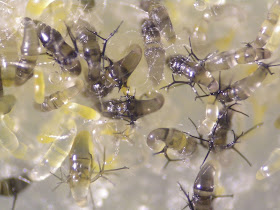Anyone who has hiked a few of our Ozark forests has likely seen these bracket fungi growing like shelves on dead or living trees. They are called Trametes aesuli now, but the books still call them Trametes elegans. They are tough, leathery and hard to break off the tree. These are hardened members of the polypore group of fungi. We collect them for WOLF School students to paint on.
 This is a great example of nature's recycling. Trametes fungus species grow on trees which have some dead tissue, a process called sap rot. Fungi send enzymes out of their fine hyphal threads to break down the wood and digest the cellulose, a hard trick for anything that has legs. Even termites depend on microorganisms in their gut to grind the cellulose into something they can turn into energy. The hard fruiting bodies of these polypores have nutrition that few legged creatures can use. This is where fungus beetles enter the picture. These species are obligate fungivores (fungus-eaters), meaning that their specialized digestive systems can only digest fungi. A prime example are the Neomida bicornis below.
This is a great example of nature's recycling. Trametes fungus species grow on trees which have some dead tissue, a process called sap rot. Fungi send enzymes out of their fine hyphal threads to break down the wood and digest the cellulose, a hard trick for anything that has legs. Even termites depend on microorganisms in their gut to grind the cellulose into something they can turn into energy. The hard fruiting bodies of these polypores have nutrition that few legged creatures can use. This is where fungus beetles enter the picture. These species are obligate fungivores (fungus-eaters), meaning that their specialized digestive systems can only digest fungi. A prime example are the Neomida bicornis below. |
| Neomida bicornis found in bracket fungi - REK |
 I was recently surprised to discover that T. elegans is the main course in the diet of Neomida bicornis. I stored several hard dried fungi in a sealed plastic bag for future artists and when I opened it six months later they were riddled with holes. In the bottom of the bag there was lots of powder as well as over 100 little black dots. On closer inspection they were fungus beetles that had eaten their fill before dying of dehydration and old age.
I was recently surprised to discover that T. elegans is the main course in the diet of Neomida bicornis. I stored several hard dried fungi in a sealed plastic bag for future artists and when I opened it six months later they were riddled with holes. In the bottom of the bag there was lots of powder as well as over 100 little black dots. On closer inspection they were fungus beetles that had eaten their fill before dying of dehydration and old age.
The WOLF School students made another discovery while examining the beetles under the microscope, a beetle larva that had been hidden in the frass. It has been dried for months and I can only find these photographs of the larva in their living state, so I can only assume that it is also N. bicornis.
 |
| Neomida bicornis - REK |
"Members of Neomida are diagnosed by the following features (taken from Triplehorn 1965): antennal club loose and with seven antennomeres; eyes emarginate anteriorly close to antennal insertions, forming a lower portion at least twice as long as the upper portion; head of males usually bearing horns or tubercles on frons or clypeus, or both; prosternal process convex; elytral punctation seriate; basal tarsomere of hind tarsi short." Zookeys
 |
| Katja Schulz |
===========
Even tiny 3mm beetles can carry smaller mites. See this photo by Tom Murray!













































